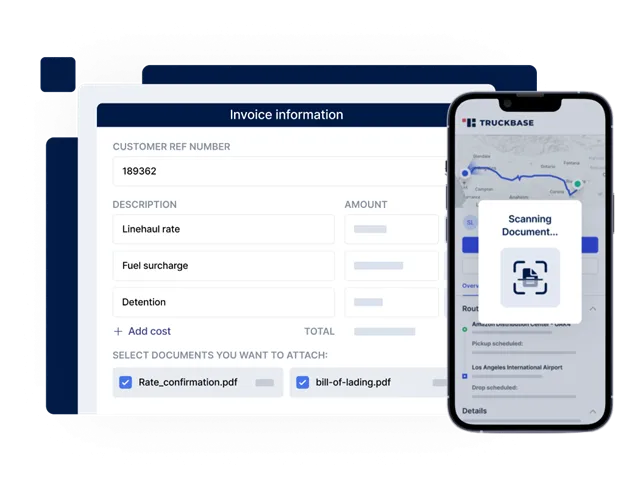Best Trucking Software 2024

For growing asset-based carriers, ensuring you have the right trucking software is essential for managing fleets, optimizing operations, and winning more higher-paying loads. Depending on your size, growth plans, and focus (by freight, geography, or otherwise), you will want to carefully vet the right trucking software provider for you. Just as different carriers have their own unique strengths and weaknesses, so do different trucking software companies.
In this article, we will explore the top five trucking software providers for 2023-24, taking into account their feature sets, target customers, and overall performance.
Truckbase: Intuitive and modern cloud-based software for the 10-100 truck fleet
Truckbase (www.truckbase.com) stands out as an intuitive and easy-to-use trucking software that dispatchers and drivers love. Ideal for asset-based carriers with 10-100 drivers, Truckbase offers a more professional and reliable system, built with modern tech that will impress brokers and shippers. Truckbase makes the most sense once you have multiple users in the system who need to collaborate, such as having at least one dispatcher and an operations manager.
Truckbase’s software revolves around three core feature sets – dispatching, invoicing, and settlements – as well three core integration types – truck tracking through ELDs, QuickBooks, and EDI connections.
Truckbase built the software with ease-of-use and user-friendliness in mind. It is intuitive and easy enough to learn that you can have team members dispatching loads on the first day using it. In our mobile-first world, the software is mobile friendly with apps for dispatchers, admins, and drivers.
It decreases data entry by leveraging AI, with fleets claiming it reduces manual workloads by 30%. And its dispatch functionality is where Truckbase really stands out, which makes them a great fit for fleets focused on usability for drivers.
Unlike more enterprise trucking software options, Truckbase software requires very little training, yet still offers enterprise-grade functionality such as live vehicle tracking, EDI & ELD integrations, and customer portals.
Additionally, as a nimble and rapidly growing player built on modern technology, their team prides themselves on highly responsive customer support. Their customer-centric development process results in fast updates and improvements that set them apart from legacy players who move at a slower pace. For the growing small-to-mid-size fleet, Truckbase is your answer.

Veteran solutions for trucking giants
Several trucking dispatch software providers have been around for nearly three decades, emerging during the early stages of software adoption in the industry. These solutions are often regarded as the most robust Transportation Management System (TMS) options available. With their extensive feature sets, they cater to virtually every conceivable requirement. Their highly customizable nature allows fleets to tailor the software to their specific needs, ensuring a perfect fit.
However, this level of customization comes at a cost – a lengthier and more complex implementation process, accompanied by higher price tags. These solutions are best suited for large fleets with 500 or more trucks that are prepared to approach their software selection as a significant investment. While the user interface may feel somewhat dated, these veteran solutions remain a top choice for mega carriers due to their comprehensive feature offerings and high degree of customization.
Low-cost solutions for owner operators
Affordable Basics for Owner Operators and Small Fleets
Several software providers offer more affordable options with limited functionality, catering to owner-operators and small fleets with 1-5 trucks. These solutions are suitable for record-keeping at home but less ideal for dispatch operations due to their lack of driver functionality.
The software is best suited for a single user, such as an owner who manages both dispatching and accounting, as collaboration features are limited. When evaluating these options, consider your specific needs, as they tend to have varying strengths. For example, some are better suited for owner-operators who work with a handful of brokers or shippers and do not require load board integrations.
If users are willing to dedicate time to weekly data entry, these solutions can provide detailed cost tracking and reporting capabilities.
If you have a brokerage arm, ensure to evaluate which of these lower-cost trucking dispatch software options include modules specifically tailored for brokerages.
However, fleets aiming for growth or requiring advanced features like driver apps, live tracking, or mobile scanning may find the free, low-cost solutions inadequate. Many of these also necessitate extensive manual data entry, a significant drawback compared to more modern trucking dispatch platforms that utilize AI to drastically reduce manual workloads for dispatchers.
Additionally, numerous lower-cost options suffer from outdated user interfaces and technologies, making them susceptible to performance issues, sluggishness, and unintuitive designs, much like the software used by larger carriers.
Google Sheets: The free and basic option
Startup trucking companies, owner operators, or those operating under the most limited budget constraints might find Google Sheets fitting their basic dispatch needs. Effectively a web-based version of Microsoft Excel, it allows for multiple users in the software simultaneously and can be accessed from anywhere. Those familiar with extracting maximum value from spreadsheets and custom macros may not feel limited by its generalist purpose. Yet, without trucking-specific workflows or capabilities, its scope is inherently limited, lacking the dedicated dispatch-oriented features seen in specialized trucking software solutions.
Conclusion
Choosing the right trucking software is a critical decision that can significantly impact your fleet's efficiency, profitability, and growth potential. As the trucking industry continues to evolve, having a reliable and scalable software solution becomes increasingly important.
For growing asset-based carriers with 10-100 trucks, Truckbase emerges as a compelling option, offering an intuitive, modern, and user-friendly platform designed specifically for fleets of this size. Its focus on ease of use, AI-powered automation, and robust dispatching capabilities make it an attractive choice for carriers seeking a professional and reliable system.
Larger carriers with 500 or more trucks may find the highly customizable and feature-rich veteran solutions more suitable, despite their higher costs and potentially dated user interfaces. These solutions cater to the complex requirements of mega carriers, providing unparalleled flexibility and depth.
Owner-operators and small fleets with limited budgets can explore the affordable, low-cost options available, while keeping in mind their limitations in terms of advanced features and potential for growth.
Ultimately, the choice of trucking software should align with your fleet's size, growth plans, and specific operational needs. By carefully evaluating the available options and considering factors such as feature sets, scalability, and ease of use, you can make an informed decision that will position your trucking business for long-term success in an increasingly competitive industry.
Other articles to check out:
- Best Truck Dispatch Software
- Trucking Management Software Buyer’s Guide
- QuickBooks for Trucking
- Best Carrier TMS Software: How to Choose
The above article is sponsor-generated content. To learn more about sponsor-generated content, click here.

